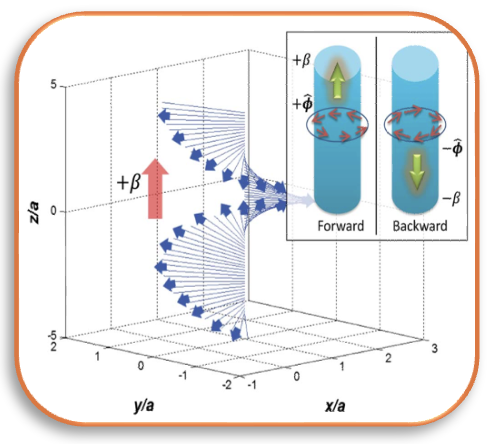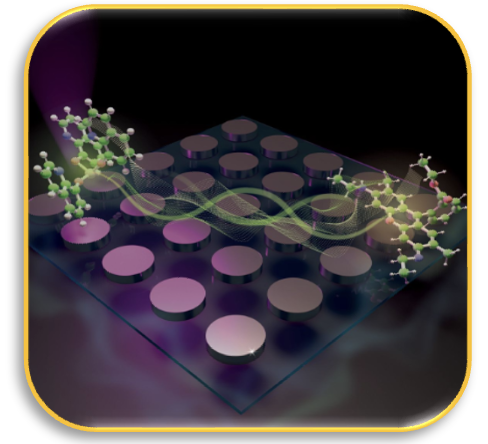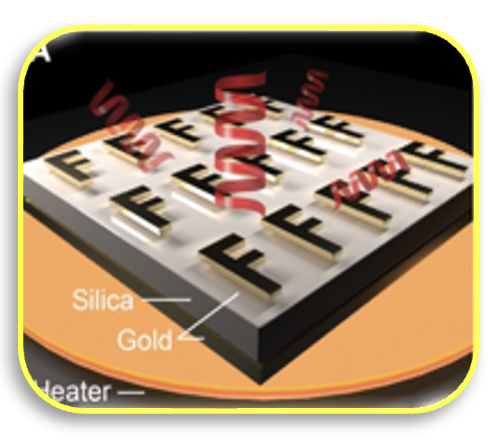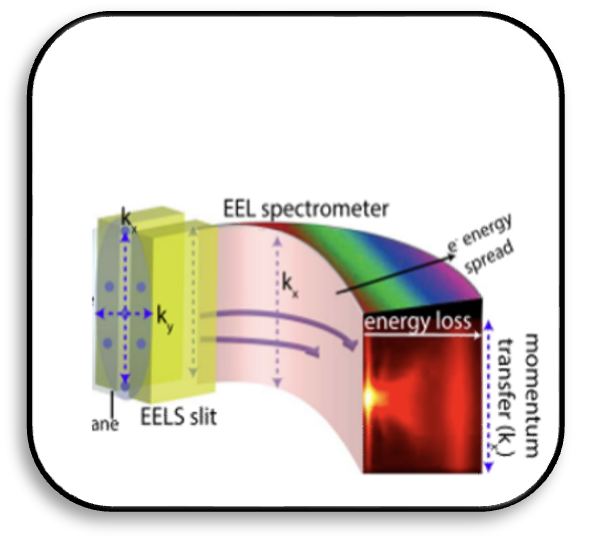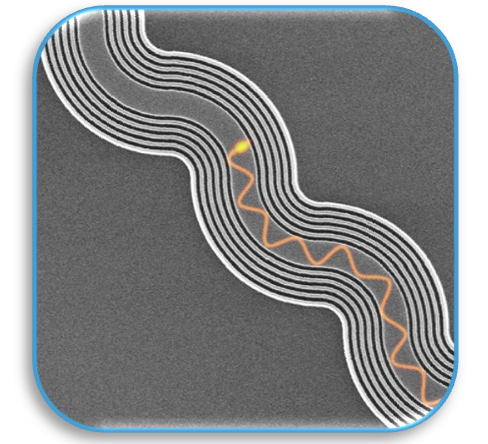The traditional expertise of our group is in the area of Energy and Nanophotonics. The breadth of our research puts us in a unique position consisting of advancements across the EM spectrum from THz to UV. While we work on a diverse range of topics, the following key projects will provide an insight into some of our contributions in this area:
Energy + Nanophotonics
Spin Angular Momentum of Light
We show the existence of an inherent property of evanescent electromagnetic waves: spin-momentum locking, where the direction of momentum fundamentally locks the polarization of the wave. We trace the ultimate origin of this phenomenon to complex dispersion and causality requirements on evanescent waves. We demonstrate that every case of evanescent waves in total internal reflection (TIR), surface states, and optical fibers/waveguides possesses this intrinsic spin-momentum locking. We also introduce a universal right-handed triplet consisting of momentum, decay, and spin for evanescent waves. We derive the Stokes parameters for evanescent waves, which reveal an intriguing result—every fast decaying evanescent wave is inherently circularly polarized with its handedness tied to the direction of propagation. We also show the existence of a fundamental angle associated with TIR such that propagating waves locally inherit perfect circular polarized characteristics from the evanescent wave. This circular TIR condition occurs if and only if the ratio of permittivities of the two dielectric media exceeds the golden ratio. Our work leads to a unified understanding of this spin-momentum locking in various nanophotonic experiments and sheds light on the electromagnetic analogy with the quantum spin-Hall state for electrons.
Dipole-Dipole Interactions
Dipole-dipole interactions (Vdd) between closely spaced atoms and molecules are related to real photon and virtual photon exchange between them and decrease in the near field connected with the characteristic Coulombic dipole field law. The control and modification of this marked scaling with distance have become a long-standing theme in quantum engineering since dipole-dipole interactions govern Van der Waals forces, collective Lamb shifts, atom blockade effects, and Förster resonance energy transfer. We show that metamaterials can fundamentally modify these interactions despite large physical separation between interacting quantum emitters. We demonstrate a two orders of magnitude increase in the near-field resonant dipole-dipole interactions at intermediate field distances (10 times the near field) and observe the distance scaling law consistent with a super-Coulombic interaction theory curtailed only by absorption and finite size effects of the metamaterial constituents. We develop a first-principles numerical approach of many-body dipole-dipole interactions in metamaterials to confirm our theoretical predictions and experimental observations. In marked distinction to existing approaches of engineering radiative interactions, our work paves the way for controlling long-range dipole-dipole interactions using hyperbolic metamaterials and natural hyperbolic two-dimensional materials.
Thermal Photonic Materials
Thermal radiation is omnipresent and is engineered for various applications in modern photonics, such as cooling, imaging, and energy harvesting. This has motivated a continued search for platforms to tailor the spectrum, polarization, and directivity of heat radiation. Unlike laser light which has been engineered extensively through various devices, heat radiation is incoherent and poses unique challenges. Recent efforts in the field of thermal photonics have achieved significant advances using infrared metamaterials but the ability to control thermal radiation is still limited by two key factors. First, photonic strategies generally act over a narrow spectral region, whereas thermal radiation has a broad spectrum that changes with temperature. Second, the material database of thermal photonics is limited as many materials drastically lose their stability at elevated temperatures. Our work aims to resolve these limitations leading to exciting applications in the infrared space.
DUV/EUV/EELS
Strong nanoscale light–matter interaction is often accompanied by ultraconfined photonic modes and large momentum polaritons existing far beyond the light cone. A direct probe of such phenomena is difficult due to the momentum mismatch of these modes with free space light, however, fast electron probes can reveal the fundamental quantum and spatially dispersive behavior of these excitations. Here, we use momentum-resolved electron energy loss spectroscopy (q-EELS) in a transmission electron microscope to explore the optical response of plasmonic thin films including momentum transfer up to wavevectors (q) significantly exceeding the light line wave vector. We show close agreement between experimental q-EELS maps, theoretical simulations of fast electrons passing through thin films and the momentum-resolved photonic density of states (q-PDOS) dispersion. Although a direct link between q-EELS and the q-PDOS exists for an infinite medium, here we show fundamental differences between q-EELS measurements and the q-PDOS that must be taken into consideration for realistic finite structures with no translational invariance along the direction of electron motion. Our work paves the way for using q-EELS as the preeminent tool for mapping the q-PDOS of exotic phenomena with large momenta (high-q) such as hyperbolic polaritons and spatially dispersive plasmons.
On-chip Photonics
Ultra-compact, densely integrated optical components manufactured on a CMOS-foundry platform are highly desirable for optical information processing and electronic-photonic co-integration. However, the large spatial extent of evanescent waves arising from nanoscale confinement, ubiquitous in silicon photonic devices, causes significant cross-talk and scattering loss. Here, we demonstrate that anisotropic all-dielectric metamaterials open a new degree of freedom in total internal reflection to shorten the decay length of evanescent waves. We experimentally show the reduction of cross-talk by greater than 30 times and the bending loss by greater than 3 times in densely integrated, ultra-compact photonic circuit blocks. Our prototype all-dielectric metamaterial-waveguide achieves a low propagation loss of approximately 3.7±1.0 dB/cm, comparable to those of silicon strip waveguides. Our approach marks a departure from interference-based confinement as in photonic crystals or slot waveguides, which utilize nanoscale field enhancement. Its ability to suppress evanescent waves without substantially increasing the propagation loss shall pave the way for all-dielectric metamaterial-based dense integration.
Hyperbolic and ENZ Media
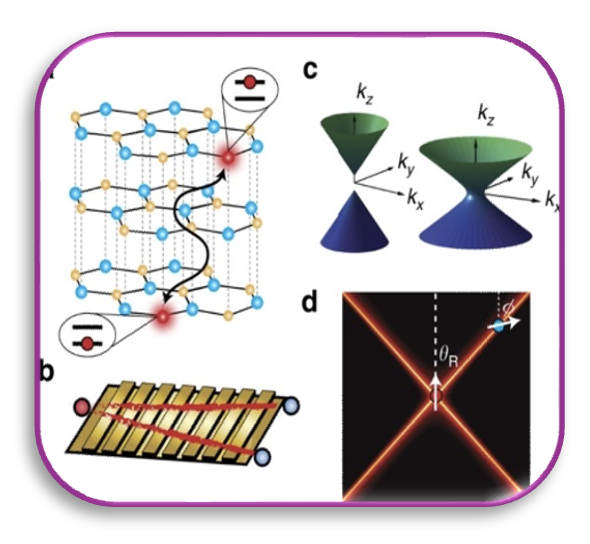
Hyperbolic and ENZ Media
The engineering of the spatial and temporal properties of both the electric permittivity and the refractive index of materials is at the core of photonics. When vanishing to zero, those two variables provide efficient knobs to control light–matter interactions. This Perspective aims at providing an overview of the state of the art and the challenges in emerging research areas where the use of near-zero refractive index and hyperbolic metamaterials is pivotal, in particular, light and thermal emission, nonlinear optics, sensing applications, and time-varying photonics.


